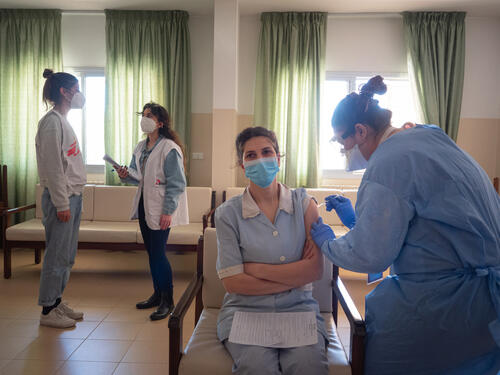International Activity Report 2021 > COVID-19: the difficulties of turning vaccines into vaccination
As the COVID-19 pandemic entered its second year, infections continued to surge around the world, affecting every country in which Médecins Sans Frontières (MSF) provides medical and humanitarian care. Although the scale and response to the pandemic was different in each country, the magnitude of the crisis stretched our capacity to respond while keeping our regular projects running and responding to emergencies elsewhere. Our main priorities continued to be strengthening infection prevention and control measures, training healthcare workers, conducting community outreach, offering mental health support and providing hospital treatment for severe COVID-19 patients.
This last, however, proved extremely challenging without effective tools to tackle the disease. With no treatment options available, mortality soared, even in the world’s best equipped hospitals. Meanwhile, many of MSF’s project locations lacked the very basics – including oxygen and ventilators – and trained intensive care staff, needed to bring death rates down. At one point in the pandemic, 84 per cent of patients admitted to intensive care at one of our hospitals in Aden, Yemen, did not survive. COVID-19 vaccines were desperately needed to fend off the ravages of the disease.
Developed at an unprecedented pace, these vaccines emerged in early 2021 and soon changed the game, at least for wealthy countries who began administering them at scale. Data affirming the vaccines’ safety and effectiveness for reducing severe illness and death soon built up in step, which in turn encouraged uptake. At this point, our patients’ outcomes should also have improved – a protection that was sorely needed given the undernourishment and/or underlying illnesses or conditions they frequently battled with. Yet they were largely left unvaccinated, as wealthy countries monopolised vaccine stocks. MSF’s Access Campaign was highly vocal on this point, stressing the need for equitable distribution worldwide and pushing hard for mechanisms to expand access.
By mid-year, vaccines had become more available, with theoretically enough to go around to meet the World Health Organization’s goal of 70 per cent vaccine coverage of the world’s population by mid-2022. Nevertheless, the ‘demand’ for vaccines in some lower-income countries turned out to be low, largely due to shortfalls in the infrastructure – a lack of roads, transport, cold chain, staff to vaccinate – needed to turn vaccines into vaccination. The low demand also wasn’t helped by a deep mistrust of the new products, and the prevalence of other health concerns, including HIV, tuberculosis, malaria and other diseases, which for many are more urgent than addressing COVID-19.
Our teams therefore witnessed the complexity of managing pandemic-scale outbreaks in low-resource settings, with global vaccination goals placing pressure on ministries of health who did not always have the means to respond and/or whose realities demanded different goals. It became clear that to improve vaccination rates, tailored approaches were needed from the outset, taking into consideration local epidemiology, feasibility and acceptability to communities. Meanwhile, our teams were grappling with other health needs that had been exacerbated by the pandemic, with already-limited resources being diverted to the COVID-19 response.
Amid all this confusion on priorities, MSF strove for an agile approach. We reinforced measures for infection prevention and control in all locations. Our teams integrated vaccination and testing into project sites in countries such as Afghanistan, Bangladesh, Central African Republic, Cameroon, Democratic Republic of Congo, Eswatini and Kenya. Vaccination and testing were also integrated into other healthcare services elsewhere – for example, via malaria treatment in Côte d’Ivoire.
Activities were adjusted according to needs; for example, in Iraq, we cared for patients with severe disease during peaks, and switched to vaccination, community outreach and staff training during ebbs. We also supported national vaccination campaigns in Lebanon, Brazil, Malawi, Peru and Uganda, with a specific focus on vulnerable or high-risk groups, while co-creating the COVAX Facility’s ‘Humanitarian Buffer’ in parallel. Designed to administer COVID-19 vaccines to people living beyond the reach or interest of states (migrants and undocumented people, or those living in conflict areas beyond government control), this mechanism is vital for providing independent humanitarian space to operate. But to date it has been crippled by legal issues and bureaucracy, and remains inaccessible for NGOs willing to assist in bringing vaccines to these groups of people. Finally, we offered all our staff access to testing and vaccination. Beyond vaccination, we ran studies on mortality and seroprevalenceThe amount of disease present in the blood among a group of people or population in countries such as Côte d’Ivoire, Cameroon and Kenya to better understand the impact of the virus locally.
Cumulatively, our 2021 COVID-19 response has provided us with food for thought on a number of significant issues. For example, on how we can better help other healthcare services withstand the damage done by the diversion of existing healthcare resources to pandemic response. Or on how we can counterbalance global vaccination goals with locally tailored solutions much earlier, when we know from our 50 years of experience that tailored solutions are always required. Or on how we can promote vaccination among communities and our staff in a more active and timely manner, even when the products are also unfamiliar to us and we are not always a key organisation in government-led vaccination campaigns. Or more generally, on how we can be more effective in vaccination campaigns.
Similar reflections are also fuelling the pandemic preparedness discussions that are now underway for ‘next time’. But we need to stay focused on the here and now. Well into the third year of the COVID-19 pandemic, we are still being confronted with waves of infection from new strains, and those people vulnerable to severe infection still need COVID-19 vaccination, treatment and care.



